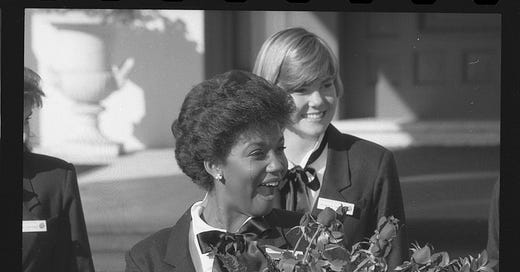“We are present—and we are looking good.”
Womanhood and race; a Haitian-American fashion history; "do you want to take your support to the next level?"; what's on our calendar...
Hello everyone,
This week we are launching a new, sustaining supporter campaign (for those of you who love a “set it and forget it” routine), exploring the complexities of ‘womanhood’ and ‘race,’ sharing an intimate Haitian-American fashion history and highlighting the legacy of Madame C.J. Walker.
The gift that keeps on giving.
Image: Josephine Baker performing in Amsterdam in 1960. Photograph by Harry Pot.
Rachel Kinnard, our Project Manager, has been working overtime to support the vision and mission of The Fashion and Race Database, and she has led the production of our special projects, such as the launch of our YouTube channel. Specifically, her production expertise helped make our ‘Retail as a Portal’ conversation series a complete success last month.
Now Rachel is helping me grow a dedicated community, and invites you to show us your support and appreciation through a monthly, sustaining donation:
Monthly donations give the Fashion and Race Database a dependable base of support. Your donations go directly toward compensating our research team, contributing writers, and covering operational costs. If you’ve been interested in providing support but you prefer to give in a recurring monthly donation, this option is for you!
If you have the willingness and the resources to support us regularly (no matter the amount), visit our donation page and select “Monthly Gift.” Thank you.
From the Library: Fashion, Womanhood, and Race
For this week’s roundup of sources from The Library, Researcher Laura Beltrán-Rubio explores the navigation of womanhood amidst the constructed boundaries of race and ethnicity:
Collective ideas about womanhood are inseparable from discourses about race and ethnicity: The bodies of racialized women have been used to shape conceptions about the exotic ‘Other’, images of erotic fantasies, and even political discourses. At the same time, women are participants—not just symbols or tools—in the (re)shaping of meanings of racialized identities.
Laura’s selections:
Black Womanhood: Images, Icons and Ideologies of the African Body by Barbara Thompson (Book)
Ain’t I a Beauty Queen?: Black Women, Beauty, and the Politics of Race by Maxine Craig (Book)
Burning the Veil: the Algerian War and the ‘emancipation’ of Muslim women by Neil MacMaster (Book)
Nazi Chic?: Fashioning Women in the Third Reich by Irene Guenther (Book)
Pious Fashion: How Muslim Women Dress by Elizabeth Bucar (Book)
Photo: “First Black Queen, Kristina Kaye Smith reacting after being chosen as the 1984 Rose Queen in Pasadena, Calif.,” 1982. Los Angeles Times, UCLA Digital Collections. digital2.library.ucla.edu
Our Library provides an ever-expanding collection of resources on ‘race,’ with its ideological and aesthetic influence shaping both history and our modern lives.
Our Fashion History: 'Les Femmes de la Perle des Antilles' by Joyce Gayo
'Our Fashion History' shares stories from contributors' photo albums in effort to expand the narrative and visual landscape of fashion history. Here, contributor Joyce Gayo shares the fashion history of her mother:
In Haitian Creole, “nou la” means “we are present—and we are looking good.” While it translates to mental fortitude, the expression also refers to Haitians’ sense of fashion. Because documentation about traditional Haitian-American clothing is not readily available, I felt honored to discover pictures of my mother, Dr. Juniace Senechales Etienne, a migrant worker turned college professor. My mother’s photos tell us a story: that of an immigrant who used fashion to assimilate into America.
Photograph: Joyce’s mother, Juniace Etienne, Naples, Florida, USA 1990. Courtesy of the author.
Visit the full story to view the resplendent photo album.
On the Calendar: ‘You Are There: 1915 Madam C.J. Walker, Empowering Women’
This week our Media Editor Daniela Hernandez turns our attention to an exhibition that celebrates the legacy of beauty entrepreneur Madame C.J. Walker. From the Eugene and Marilyn Glick Indiana History Center:
In our latest You Are There exhibit, drop in on Indianapolis icon and self-made millionaire Madam C.J. Walker at 640 N. West St. – the factory where she built her beauty product empire. Visitors can learn about Walker’s products, her method for hair growing, and the successes and struggles she and her company endured. You’ll also meet her daughter Lelia – later known as A’Lelia – her lawyer Freeman Ransom, acclaimed artist John Wesley Hardrick, George Knox – editor of the Indianapolis Freeman – and her employees and agents.More than a businesswoman, Walker helped move the lives of many people forward in positive ways. Her contributions and legacy come alive in You Are There 1915: Madam C.J. Walker, Empowering Women through images and objects – many of which come from our collections – and multimedia pieces and activities.
You can get the details on how to view this exhibition by visiting the calendar page.
That’s it for this week. Stay safe and take good care.
Yours in service and solidarity,
Kim Jenkins
Founder, The Fashion and Race Database






